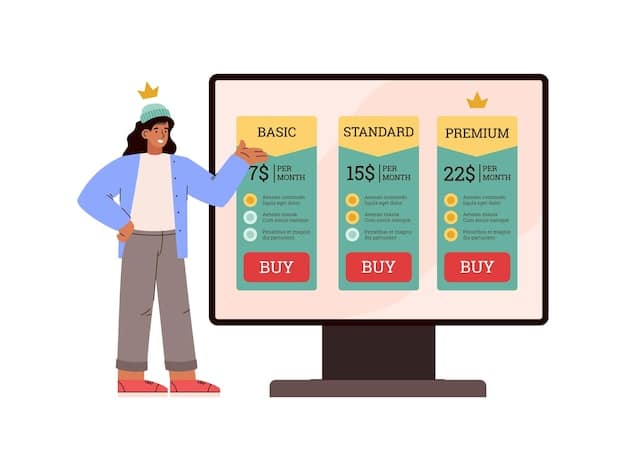Choosing the Right E-commerce Platform: ROI Analysis for US Market

Choosing the Right E-commerce Platform: A Data-Driven Analysis of ROI in the US Market requires a deep dive into various platforms, considering factors like cost, features, scalability, and integration capabilities to maximize return on investment for businesses.
Navigating the complex world of e-commerce platforms can be daunting, especially when trying to understand the potential return on investment (ROI). Choosing the Right E-commerce Platform: A Data-Driven Analysis of ROI in the US Market is crucial for businesses looking to thrive in the competitive online landscape. This article provides a comprehensive overview of key considerations and data-driven insights to help you make an informed decision.
Choosing the Right E-commerce Platform: Understanding the Basics
Selecting the right e-commerce platform is a foundational step for any online business. It’s more than just picking a name; it’s about choosing a system that aligns with your business goals and potential ROI. Let’s explore the fundamental aspects of e-commerce platforms.
Types of E-commerce Platforms
E-commerce platforms come in various forms, each catering to different business needs. Understanding these types is essential for choosing the right e-commerce platform.
- Hosted Platforms: These platforms, like Shopify and BigCommerce, offer comprehensive solutions, including hosting, security, and support.
- Self-Hosted Platforms: Platforms like WooCommerce and Magento require you to manage your own hosting and security.
- Marketplace Platforms: These are platforms like Etsy or Amazon which offer immediate access to a large customer base.
Key Features to Consider
When evaluating platforms, several core features should be on your radar.
- Scalability: Can the platform handle your business growth?
- Integration Capabilities: Does it integrate with your existing systems (CRM, email marketing, etc.)?
- SEO Friendliness: Is the platform optimized for search engines?
Choosing the right e-commerce platform involves understanding the different types of platforms and assessing the crucial features each offers, ensuring alignment with your business needs and objectives.
Analyzing ROI: A Data-Driven Approach to Choosing the Right E-commerce Platform
Calculating ROI involves understanding both the costs and potential revenues associated with each platform. A data-driven approach ensures that your decision is grounded in facts and figures, rather than guesswork.

Calculating Initial Investment
The initial investment includes setup fees, design costs, and any necessary software or plugins. Let’s break down the components.
- Platform Fees: Monthly or annual subscription costs.
- Design and Development: Costs for customizing the platform to match your brand.
- Software and Plugins: Expenses for additional features and integrations.
Projecting Revenue and Profit
Estimating potential revenue and profit requires market research and sales forecasting.
- Market Analysis: Understanding your target market and competition.
- Sales Forecasting: Projecting sales based on historical data and market trends.
- Profit Margins: Calculating profit after deducting all costs.
A data-driven approach to choosing the right e-commerce platform involves accurately calculating initial investment and projecting revenue and profit, ensuring a well-informed and financially sound decision.
Comparing Popular E-commerce Platforms in the US Market
The US market offers a variety of e-commerce platforms, each with its strengths and weaknesses. Comparing these platforms can help you narrow down your options.
Shopify: A User-Friendly Option
Shopify is known for its ease of use and comprehensive features. It is an excellent starting point for choosing the right e-commerce platform.
- Pros: User-friendly interface, strong app ecosystem, and excellent customer support.
- Cons: Transaction fees (if not using Shopify Payments), limited customization options.
WooCommerce: Flexibility and Customization
WooCommerce, a WordPress plugin, offers unparalleled flexibility and customization.
- Pros: Open-source, highly customizable, and a large community for support.
- Cons: Requires technical expertise, managing hosting and security is your responsibility.
BigCommerce: Scalability and Enterprise Features
BigCommerce is designed for larger businesses with complex needs.
- Pros: Scalable infrastructure, advanced marketing tools, and robust analytics.
- Cons: Higher price point, steeper learning curve compared to Shopify.
Comparing popular platforms like Shopify, WooCommerce, and BigCommerce allows for a clearer understanding of their respective advantages and disadvantages, facilitating a more informed decision when choosing the right e-commerce platform.

The Impact of Integrations on E-commerce ROI
Integrating your e-commerce platform with other business systems can significantly impact your ROI. Seamless integrations streamline processes, enhance customer experience, and improve data accuracy.
CRM Integration: Enhancing Customer Relationships
Integrating your e-commerce platform with a Customer Relationship Management (CRM) system allows you to manage customer data effectively.
By centralizing customer information, choosing the right e-commerce platform often comes down to easy integration with a CRM system to improve customer service and personalize marketing efforts.
Payment Gateway Integration: Streamlining Transactions
A reliable payment gateway is crucial for processing transactions securely and efficiently.
Integrating with popular payment gateways like PayPal and Stripe increases customer trust and reduces cart abandonment rates. This influences the data used when choosing the right e-commerce platform.
Marketing Automation: Boosting Sales
Integrating with marketing automation tools like Mailchimp and Klaviyo allows you to automate email marketing campaigns and personalize customer communications. The integration here factors into choosing the right e-commerce platform so that you meet marketing needs easily.
- Improves customer engagement.
- Increases conversion rates.
- Drives repeat purchases.
The impact of integrations on e-commerce ROI is substantial, with integrations like CRM, payment gateways, and marketing automation boosting efficiency, customer satisfaction, and ultimately, profitability.
Future Trends in E-commerce Platforms and ROI
The e-commerce landscape is constantly evolving, and staying ahead of the curve is essential for maximizing ROI. Understanding future trends can help you prepare for the future.
Artificial Intelligence (AI) and Personalization
AI is transforming e-commerce by enabling personalized shopping experiences. When choosing the right e-commerce platform it is essential to look at elements like:
- Personalized product recommendations.
- AI-powered chatbots for customer support.
- Predictive analytics for sales forecasting.
Mobile Commerce (M-commerce) Optimization
With the increasing use of mobile devices for online shopping, optimizing your e-commerce platform for mobile commerce is crucial.
A mobile-friendly design enhances the shopping experience and increases conversion rates. The ability to optimize mobile commerce is part of choosing the right e-commerce platform.
Sustainability and Ethical Practices
Consumers are increasingly concerned about sustainability and ethical practices. This is why choosing the right e-commerce platform often looks at the ability to:
- Highlight sustainable products.
- Partner with ethical suppliers.
- Implement eco-friendly shipping practices.
Future trends in e-commerce platforms and ROI include the integration of AI, mobile commerce optimization, and a focus on sustainability, all of which contribute to enhanced customer experiences and increased profitability.
| Key Factor | Brief Description |
|---|---|
| 💡 Platform Fees | Monthly or annual subscription costs for using the platform. |
| 📈 Scalability | Ability of the platform to handle business growth. |
| 🤝 Integrations | Compatibility with other tools like CRM and marketing automation. |
| 🤖 AI Features | Use of AI tools for personalization and customer support. |
Frequently Asked Questions
Consider factors like scalability, integration capabilities, pricing, ease of use, and the platform’s ability to support your specific business needs for effectively choosing the right e-commerce platform.
Calculate ROI by subtracting the total costs (setup, maintenance, fees) from the total revenue generated through the platform, then dividing by the total costs and multiplying by 100.
Shopify is often recommended for small businesses due to its user-friendly interface, robust app ecosystem, and affordable pricing plans when choosing the right e-commerce platform.
Integrating with a CRM enhances customer data management, improves customer service, personalizes marketing efforts, and ultimately boosts sales and customer retention.
Mobile optimization is crucial as a significant portion of online shopping occurs on mobile devices, ensuring a seamless mobile experience enhances customer satisfaction and drives higher conversion rates. This is key for choosing the right e-commerce platform.
Conclusion
Choosing the Right E-commerce Platform: A Data-Driven Analysis of ROI in the US Market involves a thorough understanding of platform types, ROI calculation, and future trends. By carefully evaluating your options and leveraging data-driven insights, you can make the best decision for your business.





